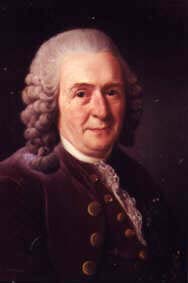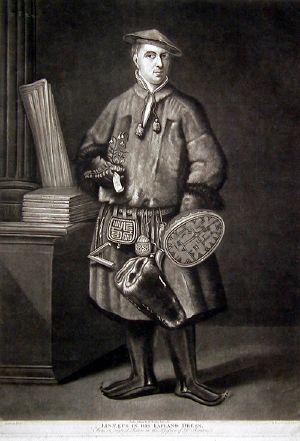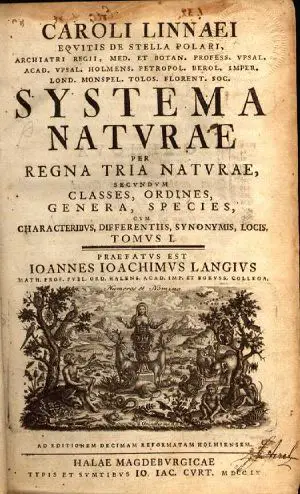Encyclopedia, Difference between revisions of "Carolus Linnaeus" - New World
m (Linnaeus, Carolus moved to Carolus Linnaeus) |
|||
| Line 1: | Line 1: | ||
| + | {{Contracted}}{{Status}} | ||
{{epname}} | {{epname}} | ||
[[Image:Carl von Linné.jpg|right|thumb|Carolus Linnaeus]] | [[Image:Carl von Linné.jpg|right|thumb|Carolus Linnaeus]] | ||
Revision as of 14:57, 16 January 2006
Carl Linnaeus, also known after his ennoblement as Carl von Linné ▶, and in English usually under the Latinized name Carolus Linnaeus (May 23, 1707 – January 10, 1778), the name with which his publications were signed, was a Swedish botanist and physician who laid the foundations for the modern scheme of taxonomy. He is also considered one of the fathers of modern ecology (see History of ecology).
Biography
Carl Linnaeus was born at a farm called Råshult in Älmhult Municipality, the province of Småland in southern Sweden. Like his father and maternal grandfather, Linnaeus was groomed as a youth to be a churchman, but he showed little enthusiasm for it. His interest in botany impressed a physician from his town and he was sent to study at Lund University, transferring to Uppsala University after one year.
During this time Linnaeus became convinced that in the stamens and pistils of flowers lay the basis for the classification of plants, and he wrote a short work on the subject that earned him the position of adjunct professor.
In 1732 the Academy of Sciences at Uppsala financed his expedition to explore Lapland, then virtually unknown. The result of this was the Flora Laponica published in 1737.
Thereafter Linnaeus moved to the continent. While in The Netherlands he met Jan Frederik Gronovius and showed him a draft of his work on taxonomy, the Systema Naturae which in its 10th edition, published in 1758, classified 4,400 species of animals and 7,700 species of plants.
In it, the unwieldy descriptions mostly used at the time, such as "physalis amno ramosissime ramis angulosis glabris foliis dentoserratis", were replaced by the concise and now familiar genus-species names in the form Physalis angulata. Higher taxa were constructed and arranged in a simple and orderly manner. Although the system now known as binomial nomenclature was developed by the Bauhin brothers (see Gaspard Bauhin and Johann Bauhin) almost 200 years earlier, Linnaeus may be said to have popularized it within the scientific community.
Linnaeus named taxa in ways that personally struck him as common-sensical; for example, human beings are Homo sapiens (see sapience). He also briefly described a second human species, Homo troglodytes ("cave-dwelling man"). This was however likely a confusion originating from exaggerated second- or third-hand accounts of the chimpanzee (currently most often placed in a different genus, as Pan troglodytes).
The group "mammalia" are named for their mammary glands because one of the defining characteristics of mammals is that they nurse their young. Of all the features distinguishing the mammals from other animals, Linnaeus may have picked this one because of his views on the importance of natural motherhood. He campaigned against the practice of wet nursing, declaring that even aristocratic women should be proud to nurse their own children.
In 1739 Linnaeus married Sara Morea, daughter of a physician. He ascended to the chair of medicine at Uppsala two years later, soon exchanging it for the chair of Botany. He continued to work on his classifications, extending them to the kingdom of animals and the kingdom of minerals. The last may seem somewhat odd, but the theory of evolution was still a long time away. Linnaeus was only attempting a convenient way of categorizing the elements of the natural world. Still, Linnaeus' research had begun to take science on a path that diverged from what had been taught by religious authorities; the local Lutheran Archbishop had accused him of "impiety." In a letter [1] to Johann Georg Gmelin dated February 25, 1747, Linnaeus wrote:
Non placet, quod Hominem inter ant[h]ropomorpha collocaverim, sed homo noscit se ipsum. Removeamus vocabula. Mihi perinde erit, quo nomine utamur. Sed quaero a Te et Toto orbe differentiam genericam inter hominem et Simiam, quae ex principiis Historiae naturalis. Ego certissime nullam novi. Utinam aliquis mihi unicam diceret! Si vocassem hominem simiam vel vice versa omnes in me conjecissem theologos. Debuissem forte ex lege artis. |
It is not pleasing to me that I must place humans among the primates, but man is intimately familiar with himself. Let's not quibble over words. It will be the same to me whatever name is applied. But I desperately seek from you and from the whole world a general differerence between men and simians from the principles of Natural History. I certainly know of none. If only someone might tell me one! If I called man a simian or vice versa I would bring together all the theologians against me. Perhaps I ought to, in accordance with the law of the discipline [of Natural History]. |
The Swedish king, Adolf Fredrik, ennobled Linnaeus in 1757, and after the privy council had confirmed the ennoblement Linnaeus took the surname von Linné, later often signing just Carl Linné. His father, born Nils Ingemarsson, had adopted the Latin surname Linnaeus as more appropriate for a clergyman on his matriculation at Lund University; the name deriving from the lime [2] tree after which the family farm, Linnagård, took its name.
Declining in his later years, Linnaeus suffered from a series of strokes in 1774. He died four years later, in 1778.
Linnaean taxonomy
Although taxonomists, in almost any biological field, are familiar with the work of Carolus Linnaeus, his contribution to taxonomy goes far beyond contributing so-called scientific names to many of the world's plants and animals. Linnaeus developed, during the great 18th century expansion of natural history knowledge, what became known as the Linnaean taxonomy; the system of scientific classification now widely used in the biological sciences.
The Linnaean system classified living things within a hierarchy, starting with two kingdoms. Kingdoms were divided into classes and they, in turn, into orders, families, genera (singular: genus), and species (singular: species). Since then a few other ranks have been added, most notably phyla (singular: phylum) or divisions between kingdoms and classes. Groups of organisms at any rank are now called taxa (singular: taxon) or taxonomic groups.
His groupings were based upon shared physical characteristics. Although the groupings themselves have been significantly changed since Linnaeus' conception, as well as the principles behind them, he is credited with establishing the idea of a hierarchical structure of classification which is based upon observable characteristics.
Linnaeus was also a pioneer in defining the concept of "race". He proposed that inside of Homo sapiens, there were four subcategories. These categories are, Americanus, Asiaticus, Africanus, and Europeanus were based on place of origin at first, and later skin color. Each race had certain characteristics that members supposedly had. Native Americans were reddish, stubborn, and angered easily. Africans were black, relaxed and negligent. Asians were sallow, avaricious, and easily distracted. Europeans were white, gentle, and inventive. Linnaeus's races were clearly skewed in favour of Europeans. Over time, this classification led to a racial hierarchy, in which Europeans were at the top.
Students
His students include such renowned botanists as Pehr Kalm (from Finland) and Daniel Solander (from Sweden).
Other accomplishments
- Linnaeus is considered one of the finest prose writers in Swedish. His travel journals contain pithy notes on everything of interest he encountered, not just plants. He didn't just write from personal interest, but as a reporter to the enlightened scientific and political public. His journey to sub-Arctic Lapland is notable for exotic and adventurous episodes. He also composed some down-to-earth sex-instruction lectures published as "Om sättet att tillhopa gå" [How to go together].
- Linnaeus' original botanical garden may still be seen in Uppsala.
- He originated the practice of using the ♂ - (shield and arrow) Mars and ♀ - (hand mirror) Venus glyphs as the symbol for male and female.
- Linnaeus was instrumental in the development of the Celsius (then called Centigrade) temperature scale. Anders Celsius had proposed using 0 as the boiling point of water, and 100 as the freezing point; Linneaus inverted it to the form we are familiar with today [3].
- His picture can be found on the current Swedish 100 kronor bank notes [4].
- Linnaeus was one of the founders of the Royal Swedish Academy of Sciences.
- Linnaeus is the only botanist currently referred to by a single initial: L. (Previously, the abbreviation assigned was Linn.) In botany, the names, abbreviated, of the botanists who first describe and codify a species follow immediately after the scientific name. For example, Cocos nucifera L. is the complete scientific name for the coconut, with the "L." referring to Carolus Linnaeus.
- Linnaeus was said to be a man of great social skills. Erik Axel Karlfeldt's words "han talte med bönder på bönders vis, och med lärde män på latin" [he talked to peasants as peasants do, and to learned men in Latin] give a good characterization of his manner.
- He created the "Petal Time Clock". His findings found that different species of flowers open at different times everyday. For example, he discovered that the hawksbeard plant, opened its flowers at 6:30 am, whereas another species, the hawkbit, did not open its flowers until 7 am. After much research into this, he soon concluded that one could tell the time of day simply by watching the flowers in their garden. This method of keeping time did not catch on with everyone.
See also
- Carolus Linnaeus the Younger. Linnaeus's son, also named Carl Linnaeus and also a botanist, is commonly so referred with filius (abbreviated "L. f.") to distinguish him from his famous father.
- Linnean Society of London
- Linnaeus Arboretum
- Jonas C. Dryander
- Carl Peter Thunberg
- Frederik Hasselquist
- Peter Artedi
External links
- Linnaeus Botanical Garden
- Biography at the Department of Systematic Botany, University of Uppsala
- Biography at The Linnean Society of London
- Biography at the University of California Museum of Paleontology
- The Linnaean Correspondence
| Persondata | |
|---|---|
| NAME | Linnaeus, Carolus |
| ALTERNATIVE NAMES | Linné, Carl von |
| SHORT DESCRIPTION | botanist and physician |
| DATE OF BIRTH | 1707-05-23 |
| PLACE OF BIRTH | Älmhult, Sweden |
| DATE OF DEATH | 1778-01-10 |
| PLACE OF DEATH | |
Credits
New World Encyclopedia writers and editors rewrote and completed the Wikipedia article in accordance with New World Encyclopedia standards. This article abides by terms of the Creative Commons CC-by-sa 3.0 License (CC-by-sa), which may be used and disseminated with proper attribution. Credit is due under the terms of this license that can reference both the New World Encyclopedia contributors and the selfless volunteer contributors of the Wikimedia Foundation. To cite this article click here for a list of acceptable citing formats.The history of earlier contributions by wikipedians is accessible to researchers here:
The history of this article since it was imported to New World Encyclopedia:
Note: Some restrictions may apply to use of individual images which are separately licensed.



